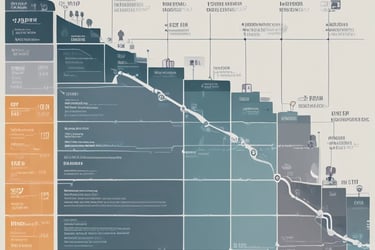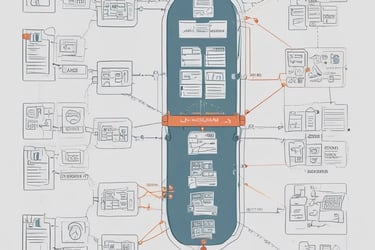The ROI of Automation: How ERPNext Cuts Costs and Boosts Margins for MSMEs
Learn how MSMEs can achieve a rapid return on investment by automating key processes with ERPNext—reducing costs, minimizing errors, and driving higher profit margins!
Nahush Dev Verma
7/23/20253 min read


Introduction
For micro, small, and medium enterprises (MSMEs), every rupee saved and every hour reclaimed can make a critical difference to the bottom line. Yet many businesses still rely on manual data entry, patchwork software, and paper-based approvals—practices that not only consume valuable resources but also introduce costly errors. ERPNext, an open-source, modular ERP solution, offers a powerful way to automate repetitive tasks and unify your operations. By eliminating redundant work, improving accuracy, and enabling smarter decision-making, automation with ERPNext delivers a compelling return on investment (ROI) that can transform your cost structure and boost profit margins.
Understanding the Cost of Manual Processes
Manual workflows impose both visible and hidden costs. On the surface, you see hours lost to copying figures between spreadsheets, chasing signatures on purchase orders, and correcting invoice mistakes. Beneath the surface, however, lurk less obvious drains on profitability: delayed order fulfillment leading to lost sales, stockouts or overstocking eroding margin, and reactive firefighting that distracts leadership from strategic initiatives. Over a year, these inefficiencies can amount to thousands—or even lakhs—of rupees in wasted labor and opportunity costs.
How ERPNext Reduces Direct Expenses
License-Free Deployment: As an open-source platform, ERPNext lets you avoid the steep licensing fees often associated with traditional ERPs. You pay only for implementation and support, aligning costs with actual business value.
Consolidated IT Stack: By replacing multiple point solutions—accounting software, standalone inventory trackers, separate CRMs—with a single platform, you reduce subscription fees, integration headaches, and server overhead.
Fewer Errors, Lower Rework: Automated validations, built-in approval workflows, and standardized data entry forms cut down on mistakes. Fewer errors mean less time spent on rework, credit notes, and customer disputes—directly translating into lower operating expenses.
Boosting Margins Through Process Efficiency
Faster Order-to-Cash Cycle
Automation accelerates the entire order lifecycle. Online orders can flow directly into ERPNext, trigger stock reservations, generate invoices, and prompt digital payments—all without manual intervention. A shorter cash-conversion cycle frees up working capital and allows you to leverage early-payment discounts from suppliers.
Optimized Inventory Carrying Costs
Predictive analytics in ERPNext examine historical sales patterns to forecast demand more accurately. By automating reorder thresholds, you avoid both stockouts (which cost sales) and overstocking (which ties up capital and increases carrying costs), improving gross margins.
Reduced Overhead in Finance & Admin
Automated bank reconciliation, payroll processing, and expense management eliminate mundane tasks in your finance department. Staff can focus on strategic financial planning rather than data entry, enabling you to do more with the same headcount.
Measuring ROI: Key Metrics to Track
To quantify the impact of automation, MSMEs should establish baseline metrics before implementation and track improvements over time:
Labor Cost Savings: Calculate hours saved on invoicing, reconciliations, and reporting, then multiply by average hourly rates.
Error-Related Cost Avoidance: Track reductions in credit notes, write-offs, and customer support tickets attributable to data entry mistakes.
Inventory Turnover Ratio: Monitor changes in days-of-inventory-on-hand and correlate to carrying-cost reductions.
Order Cycle Time: Measure the time from order receipt to cash collection and benchmark improvements month over month.
ROI Calculation: Divide net savings (cost reductions minus implementation costs) by total implementation expense to arrive at a percentage ROI. Many MSMEs see payback in under 12 months.
Best Practices for Maximizing Returns
Start Small and Scale
Focus first on high-impact processes—such as invoicing or procurement—where automation will yield the greatest savings, then expand to other areas.
Leverage Standard Functionality
Customize sparingly. Over-customization adds complexity and cost. Instead, use ERPNext’s robust, out-of-the-box workflows and adapt your processes to fit.
Invest in Change Management
Ensure your team understands the “why” behind the new system. Provide role-specific training and clear documentation, and enlist early adopters to champion the change.
Monitor and Refine
Treat automation as an ongoing journey. Regularly review performance metrics, gather user feedback, and optimize workflows or AI models for even greater efficiency.
Conclusion
Automation with ERPNext is not just a technology upgrade—it’s a strategic lever for cost reduction and margin enhancement. By consolidating disparate tools, cutting manual errors, speeding up core processes, and optimizing inventory, MSMEs can realize significant savings and achieve rapid ROI. With clear metrics, smart change management, and a phased rollout approach, your business can transform administrative drudgery into streamlined, automated workflows that drive sustainable growth and profitability






Get to know us further by joining our social community. We upload daily content.
© 2025 NxtEdge Technologies. All rights reserved.
